



 Hall of Fame
Hall of Fame






I have assembled what I believe are some of my best images under my "Hall of Fame" gallery. As you can see from the work below, they represent various aspects of our solar system as well as many wonders millions of light years beyond it. Please remember to click on any image to get a larger rendition with further details. Enjoy!
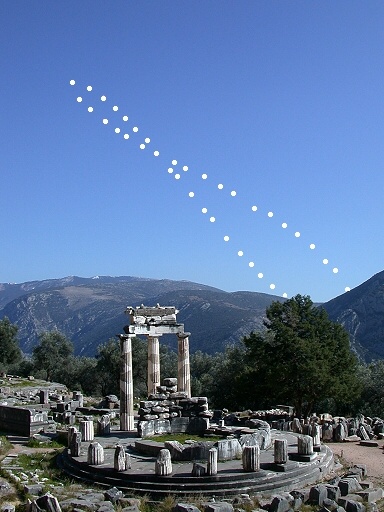 |
Title:
Sunrise Analemma with the Tholos (360-350 BC), Ancient Delphi, Greece If you were to observe the sun from precisely the same location and at the same time over a year, would its position be the same? The answer is no and the image to the left illustrates the complete motion of the sun from January to December 2002 when observed (or imaged) at precisely 08:00:00 UT+2. For additional analemma photos by the author published all over the world as well as further information in relation to the analemma, please click here. Note: Selected as PHOTO OF THE YEAR, Astronomy Now Magazine 2004 Annual Calendar (Britain). Note: Selected as Astrophoto of the Day (APOD) for Mar 20, 2003. Note: Published in Astronomy Magazine (USA). |
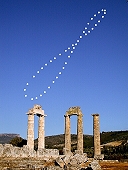 |
Title:
Summer Milky Way Perhaps the most dramatic sight of the night sky is invariably also the least observed thanks to light pollution. The Milky Way spans from horizon to horizon (Cassiopeia to Sagittarius during the summer) and literally represents our section of the universe, for this is where our solar lies and, more specifically, on the minor arm known as the "Orion spur". Aside from the thousands and thousands of stars visible even with a simple pair of binoculars, the Milky Way hosts a rich collection of nebulae, star clusters and galaxies. For a larger view of this celestial wonder, please click on the image to the left. For additional images of the Milky Way, please click here. Note: Selected as Photo of the Day for Jul 13, 2005 by Astronomy Magazine (USA). Note: Published in Astronomy Heute (Germany). Note: Published in Sky&Telescope (USA). |
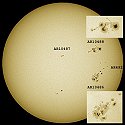 |
Title:
Our Star Ablaze Solar activity and, more specifically, sunspots and sunspot groups have been noted to vary in eleven-year cycles. During the minimum of these cycles, sunspots and sunspot groups are relatively scarce as compared to the maximum of the cycle when these same formations dominate the solar disk. During the fall of 2003 and at a stage of the solar cycle characterized as solar minimum, two massive active regions, AR10484 and AR10486, and each greater in size than the planet Jupiter (!) appeared only spaced days apart. For a large view of some "monster" sunspot groups, click on the image to the left. For additional images of sunspots and sunspot groups, click here. |
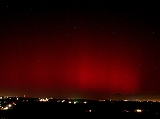 |
Title:
Aurora Borealis in Greece: The Impossible Possible?! One of nature's most impressive and stunning displays is the "dancing lights" commonly referred to as Aurora Borealis in the Northern Hemisphere and Aurora Australis in the Southern Hemisphere where coronal mass ejections from the sun interact by ionizing particles present in earth's atmosphere, thus leading to the emission of light and the consequent production of amazing and colorful displays across the planet's two geomagnetic poles. The Mediterranean and Greece, in particular, are so distant from the geomagnetic pole that such an event is virtually impossible. However, thanks to AR10484, the impossible became possible late one evening in Nov/2003. For additional and very rare images of auroral displays from the land of Apollo and Zeus, click here. Note: Published in Γεωτρόπιο (Greece). Note: Published in Popular Science (Greece). |
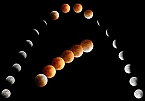 |
Title:
A Total Lunar Eclipse Mosaic One of the most impressive events visible to the unaided eye is a solar or lunar eclipse. For the latter, the observer is privy to a display lasting a few hours and whereby the moon and our closest celestial neighbour is in a constant metamorphosis involving its appearance (phase), brilliance and coloration. The image to the left documents the total lunar eclipse in early May/2004 which lasted approximately four hours and illustrates the eclipse from start to finish. For a larger rendition of this particular majestic event, click on the image to the left. For additional eclipses - solar and lunar - please click here. Note: Selected as Astrophoto of the Day (APOD) for May 06, 2004. Note: Selected as Lunar Photo of the Day (LPOD) for May 05, 2004. Note: Selected as COVER PHOTO, Ouranos Magazine (Greece). |
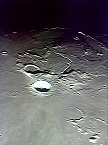 |
Title:
The Moon In ... Living Color!!! Perhaps the single-most intriguing and diverse region of the moon is the Aristarchus Plateau, an area on the northern outskirts of Oceanus Procellarum where a 40-km crater, Aristarchus, is the brightest feature on the moon (visible even during earthshine); where the largest rille measuring 160 km in length is found to traverse Valles Schroeteri; where an elevated formation 2-km in height (Aristarchus Plateau) provides for surreal three-dimensional views; and, a wide variety of colouration is noticed on a body typically regarded to be dull and monochrome. More details about this "colourful" region of the moon, believed to be a mere 450 million years old, is available by clicking on the image to the left. For additional lunar features by morphological category, please click here. Note: Published in Astronomi (Norway). Note: Published in Popular Astronomy (Britain). Note: Published in Star Observer (Austria). |
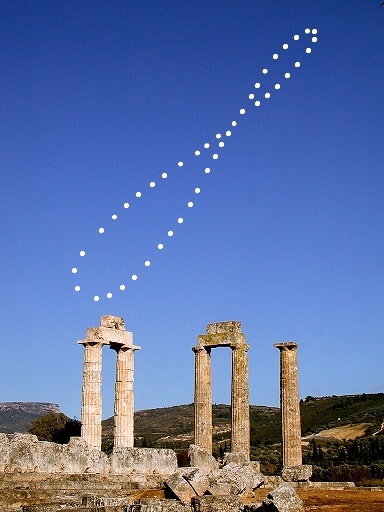 |
Title:
Analemma with the Temple of Zeus (340-330 BC), Ancient Nemea, Greece If you were to observe the sun from precisely the same location but during mid-afternoon in lieu of early morning (see analemma above), would its angle be the same? The answer is no as illustrated by the image to the left which represents the complete motion of the sun from January to December 2003 when observed (or imaged) at precisely 16:00:00 UT+2. For additional analemma photos by the author published all over the world as well as further information in relation to the analemma, please click here. Note: Selected as Astrophoto of the Day (APOD) for Jun 21, 2004. Note: Published in Sky&Telescope (USA). Note: Published in Zvezdotchet Magazine (Russia). |
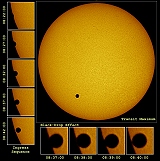 |
Title:
Aphrodite Exposed One of the rarest events that one may observe is that involving the transit of Venus against the sun's disk, an event which has been observed only six times since the invention of the telescope (!) and which no one currently alive had witnessed until the fateful event of June 8, 2004. Due to the tilt of Venus' orbit around the sun in relation to the ecliptic, these events are not as common as one would think or expect and occur only in pairs (ascending and descending nodes) once every 105.5 or 121.5 years when the Sun, Venus and Earth do manage to be in alignment with each other. For additional images of this very rare and stunning celestial event, please click here. Note: Published in Astronomie Heute (Germany). Note: Published in Astronomy Now (Britain). Note: Published in Sky&Space (Australia). |
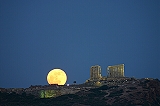 |
Title:
Selene Rising Although the full moon has risen and set nearly fifty million times during man's presence on this planet, the sight of our closest celestial neighbour rising and setting is always a breath-taking event. When this majestic "resurrection" is against a stunning foreground such as the Temple of Poseidon at Sounio, Greece, the event takes on an even greater meaning as amply illustrated by the image to the left. For additional images of this very majestic celestial event, please click here. Note: Selected as Astrophoto of the Day (APOD) for Jun 23, 2005. Note: Selected as Photo of the Day (Astronomy Magazine) for May 28, 2005. Note: Selected as COVER PHOTO, Popular Astronomy (Britain). |
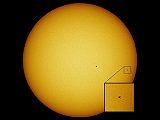 |
Title:
ISS and Discovery in Transit Following Skylab and Mir, the latest entry in orbit around our planet is the International Space Station. This piece of latest technology measures nearly 80 meters in length and represents the culmination of over seven years worth of work by a consortium of sixteen nations (United States, Russia, Canada, Japan and Europe). With an original budget of 60 billion dollars and an anticipated 35 Shuttle missions for its complete construction, the life expectancy of Space Station Alpha is thirty years. For a very rare solar transit of the ISS with the shuttle (Discovery, STS-114) attached, click on the image to the left. For additional images of this very stunning celestial event, please click here. Note: Selected as Astrophoto of the Day (APOD) for Jul 29, 2005. Note: Selected as Photo of the Day (SpaceWeather) for Jul 29, 2005. Note: Selected as Photo of the Day (Astronomy Magazine) for Jul 29, 2005. |
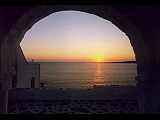 |
Title:
Aegean Sunset, Isle of Paros, Greece Our sun and closest star is believed to be 4.6 billion years old and is composed of hydrogen (74.5%), helium (23.5%) and various other heavier elements (2%) such as oxygen and carbon. It goes without saying that the sun is the basis of life on this planet thanks to its constant outpouring of energy, heat and light. For additional sunset photos from the Aegean as well as further information in relation to the astronomical definition of darkness, please click here. |
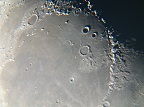 |
Title:
Mare Imbrium (Sea of Rains) This large circular formation lying in the northwestern quadrant of the moon and whose diameter of 1250 kilometers and area of approximately 830,000 sq meters make it the second largest mare on the moon. For some impressive surface coloration, incredible detail including craters less than 6 km in diameter and marvellous shadows of this 3.80-3.85 billion year-old formation, please click on the image to the left. For additional lunar features by morphological category, please click here. |
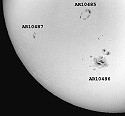 |
Title:
Sunspot Groups AR10485-487 Perhaps the most obvious feature of the sun is the sunspots that characterize the photosphere. Due to the differential rate of rotation of the solar disk (26 days at the equator and 36 days at the poles), there is a "twisting" of the magnetic fields which surface to the photosphere producing sunspots. Typically, these spots and groups are found to lie + 30° of the solar equator and can physically be many-fold times larger than our planet! One such example is AR10486 to the left which expanded to multiple earth-diameters in size. For a larger view of the image on the left, click on the image itself. For additional images of sunspots and sunspot groups, click here. |
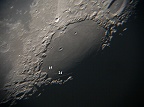 |
Title:
Mare Crisium (Sea of Crises) Lying on the eastern limb of the moon and measuring approximately 600 km in diameter, this formation was the basis of a scandal involving a leading lunar observer in the late 1950's involving O'Neill's Bridge. The Sea of Crises is characterized with four dorsa (Termier, Harker, Oppel and Tetyaev), a couple of craters (Picard and Peirce) and is the site for a crash-landing by Luna 15 in 1969 and a soft-landing by Luna 24 in 1976. For a larger rendition of this difficult to image feature, estimated to have been formed between 3.85 and 3.92 billion years ago, click on the image to the left. For additional lunar features by morphological category, please click here. Note: Published in Astronomy Magazine (USA). |